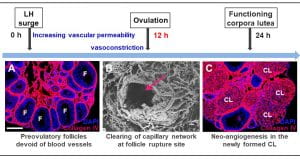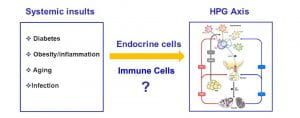Ovarian Vascular Remodeling in Ovulation and Luteal Function

What Mother Earth is to us, the ovary is to oocytes- the source of new life. The cyclic changes in the ovary’s structure and function in the reproductively active period is an ode to the highly coordinated dance between the constructive and deconstructive force of life: all have to be in the right place at the right time, and all is hormonally regulated. We are fascinated by the molecular and cellular processes underlying cyclic changes in the adult ovary, and by how their disruption contributes to infertility in women. Our current focus is the ovarian vascular system, which undergoes highly dynamic remodeling processes that are crucial for ovulation and subsequent luteal function.
New Biomarkers for Predicting and Improving Reproductive Performance in Dairy Cattle
The reproductive performance of dairy cows is central to the profitability and sustainability of the dairy industry. Despite new technologies and better herd management, less than half of current breeding efforts result in the live birth of a calf. The leading causes are functional problems in the ovary and the uterus – both are the essential organs for the establishment and maintenance of pregnancy. Our research aims to uncover the molecular and cellular basis regulating ovarian and uterine physiology in dairy cattle, which may provide new opportunities for developing targeted strategies to improve pregnancy outcomes in dairy cows. Dairy genetics transformed the dairy industry in the United States and across the world. We are also exploring epigenetics as a tool for phenotype prediction, which may enable a big leap forward in dairy cattle science.
The Role of Immune Cells in the hypothalamic-pituitary-gonadal axis

The hypothalamic-pituitary-gonadal (HPG) axis- the endocrine regulatory network controlling fertility- is influenced by physiological and pathological conditions at the systemic level, such as obesity, diabetes, infection, and aging. Infiltrating and resident immune cells in the HPG axis are forefront sensors of systemic signals within a local environment and thus may serve as a crucial link in-between. Our long-term goal is to understand how immune cells mediate the deleterious effects of prevalent systemic conditions, such as those mentioned above, on reproductive and endocrine health. To achieve this goal, we start by defining the role of immune cells in normal reproductive/endocrine development and function. As immune cells are increasingly recognized as an essential player in tissue remodeling and homeostasis, our current focus includes the role of immune cells in ovulation, as well as in the remodeling and homeostasis of the pituitary gland.
